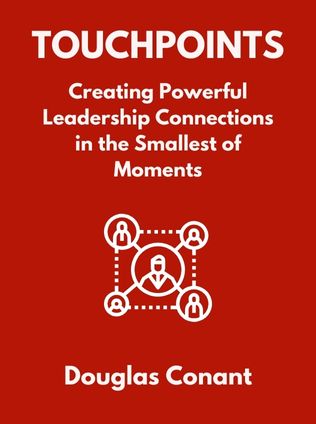
TouchPoints
Creating Powerful Leadership Connections in the Smallest of Moments
By Douglas Conant,
Published 05/2011
About the Author
Douglas Conant is a distinguished leader known for his transformative role as President and CEO of Campbell Soup Company. Under his leadership, Campbell reversed a significant decline in market value and employee engagement. Conant's tenure saw improvements in the company's financial profile, enhanced diversity and inclusion, and an elevated corporate social responsibility profile. His approach to leadership, which emphasizes the power of everyday interactions, is encapsulated in his concept of TouchPoints.
Mette Norgaard is an expert in strategic leadership and learning, advising executive teams worldwide on how to create distinct learning solutions that advance their companies' strategies. She has worked with senior leaders from Microsoft, Procter & Gamble, GE Capital, Nucor Corp, and Harley Davidson, among others. Norgaard's focus on integrating leadership with continuous learning complements Conant's practical experience, making their collaboration in "TouchPoints" a powerful combination.
Main Idea
"TouchPoints: Creating Powerful Leadership Connections in the Smallest of Moments" by Douglas Conant and Mette Norgaard presents a paradigm shift in leadership, focusing on the powerful impact of everyday interactions. The authors argue that these interactions, or TouchPoints, are opportunities to expand influence and achieve better results. They believe that a leader's legacy and impact are built through hundreds, even thousands, of these interactive moments in time.
The book introduces three essential assets for mastering TouchPoints: the head, heart, and hands. It emphasizes the importance of a rational, authentic, active, and wise approach to leadership. The authors advocate for leaders to leverage their mental models, emotional maturity, and a bias for action to transform ordinary interactions into powerful leadership moments.
Table of Contents
- The Power of TouchPoints
- The Commitment to Mastery
- Use Your Head: The Commitment to Inquiry
- Use Your Heart: The Commitment to Reflection
- Use Your Hands: The Commitment to Practice
- Mastering the Touch: How Can I Help?
- Coda
The Power of TouchPoints
It's 3:30 p.m. You're holed up in your office, trying to finish a critical proposal when a team member knocks on your door asking for advice. How do you respond? This scenario exemplifies the core idea of TouchPoints. These moments, often seen as interruptions, are in fact opportunities to lead and make a difference.
TouchPoints occur whenever two or more people come together to address an issue and get something done. These moments can be planned or spontaneous, occurring in hallways, on factory floors, in conference rooms, over the phone, or via email. They deal with straightforward issues or complex challenges. These interactions are the real work of leadership, where strategies and priorities come to life, translating ideas into actions and better behaviors.
The exponential effect of a TouchPoint capitalizes on the social networking effect. Every person you engage with is embedded in webs of relationships. Whatever you say or do in a TouchPoint may be quickly transmitted to five or six people in that person's network, and then relayed to their colleagues and so on. Therefore, when you impart a sense of urgency, people may pass that on; when you inspire confidence, that too may be transmitted; and when you blow it, people are bound to hear about it.
"You can choose to bring a sense of positive energy and direction to your very next TouchPoint, and then do it again." - Douglas Conant
To get started right away, simply take the next unplanned interaction as an opportunity to help. Twenty TouchPoints a week would add up to more than 1,000 TouchPoints in a year. This would be a very small commitment, yet the impact would be significant because you would not only feel more in control of your time, but you would also gain more influence.
The Commitment to Mastery
To succeed in leadership, you need to be good at it, and becoming good requires preparation and commitment. Mastery in leadership involves the head, heart, and hands:
- Head: A logical model that guides your approach to leading people and change.
- Heart: A clear sense of purpose and an authentic way of engaging with others.
- Hands: Practices that enable you to be prepared and competent in the moment.
These three elements come together in the art of the moment, enabling leaders to make clear judgments during TouchPoints.
The authors emphasize that if you aspire to mastery, you must use your head, heart, and hands. Your touch is where these three strands come together, allowing you to make clear judgments in the TouchPoint. When you have the touch, you can juggle multiple tasks with ease, diffuse escalating tensions, and make split-second decisions effortlessly.
Frankly, if you don't love the pressure, the sweat, and the grind, it just isn't worth it. Life is too short to be halfhearted about your work. More importantly, people deserve someone worth following. That is why we encourage you to make the commitment to mastery.
Use Your Head: The Commitment to Inquiry
Developing a leadership model that is uniquely relevant to your situation is essential for effective TouchPoints. This involves understanding your current assumptions about leadership and exploring two vital questions:
Sign up for FREE and get access to 1,400+ books summaries.
You May Also Like
The Subtle Art of Not Giving a F*ck
A Counterintuitive Approach to Living a Good Life
By Mark MansonRich Dad Poor Dad
What the Rich Teach Their Kids About Money - That the Poor and Middle Class Do Not!
By Robert T. KiyosakiHow To Win Friends and Influence People
The All-Time Classic Manual Of People Skills
By Dale CarnegieQuiet: The Power of Introverts
The Power of Introverts in a World That Can't Stop Talking
By Susan Cain



















